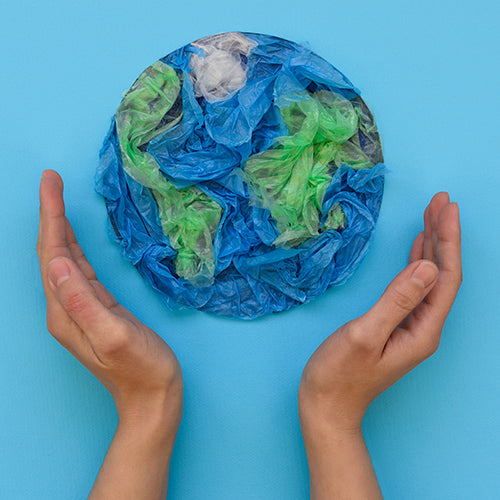Free returns sound amazing, right? Get something and if it’s not what you wanted or you don’t need it anymore, just send it back! This “returns culture” mindset makes it oh so easy to click “checkout” without much thought. Although it might seem like a harmless habit, it’s actually a huge drain on our environment.
What do I mean by ‘returns culture’?
Returns culture describes the consumer behaviour in which people order items they intend to return.
Whether they buy multiple sizes or colours in order to get the perfect fit, or just want to have a look at something, this behaviour is growing more common, due to the increase in free returns or money back guarantee policies offered by many online stores.
Customers also commonly purchase clothing online with the firm intention of returning part of their order – a global consumer survey conducted in 2020 found that this is true of 40% of respondents between the age of 21-44.
There’s also another horrifying trend, of ordering products online with the intention of returning their entire order once they have tried the items on and posted a photo on social media. A report conducted found that this accounts for 10% of consumers in the UK who bought clothing online.
A phenomenon known as Snap and Send Back, retail borrowing, wardrobing or sometimes renting.
Another phenomenon? Bracketing - it is basically when someone buys a piece of clothing in one size larger and one size smaller than what they think they might be so that at least one of them fits. Convenience, at a cost.
Are businesses training their customers to return products?
In a highly competitive online market, businesses have to stand out to get your attention, so it is really no surprise that free returns policies are common practice. In many countries, it’s also law to permit consumers to return purchases in a set timeframe.
The true cost of ‘free returns’
Globally, most beauty returns are rarely resold, regardless of whether they have been opened or not. Instead, they head to landfill due to health and safety concerns or unsaleable stock (imagine if you bought mascara that had already been used or opened?).
Clothing and other goods can be distributed back to the stores to be re-sold, shipped to discount stores or outlets, donated to charity, or sent to landfill (this process is also known as reverse logistics).
There are cases of luxury brands burning or dumping returned items to protect their brand value. In fact, ABC News reported that Burberry has destroyed more than $150 million worth of products over the last 5 years.
Let’s also focus on the carbon footprint involved with transporting the returned product for a second. According to an article published in Forbes “worldwide, approximately 17 billion items are being returned every year. This totals to 4.7 million metric tons of CO2 emitted yearly”. This article was published in 2019 so it’s likely this figure has increased since then.
Another piece of research from returns logistics firm Optoro, found that returns in the USA alone creates over 15 million metric tons of carbon dioxide emissions every year. That’s about the equivalent in emissions to three million cars.
Then there is the cost to businesses. GlobalData, an analytics company, estimates that the returns market in the UK will cost businesses £5.6 billion pounds by 2023 from transportation, sorting and disposal. The National Retail Federation in the USA estimates the cost of returns amounts to $101 billion.
All of this, without even accounting for the impact that making those products had in the first place. From the materials used, machinery and people power required to make them, greenhouse gas emissions through freighting them around the world, the shipping materials involved, and much more.
Is there a chance that return culture is creating over production? Yes, probably. If businesses start to sell more because people commonly over-order, but most of these are returns, businesses may struggle with inventory management and can over produce products for their next year.
Let’s talk about solutions
It’s a complex problem and one that can quickly make us feel like it’s all a bit of a mess. It is, but the good news is that there are businesses committed to making a difference and you can help too.
Businesses need to:
- start by producing good quality goods that will last and don’t need to be returned because they’re faulty.
- reconsider their returns policies to discourage unnecessary returns.
- be transparent about how they process returns.
At Ethique, our returns page gives background about happens when our customers return products. We are trying to front foot the potential for returns by asking to have a chat first. Often, we can solve problems for our customers and that way a return isn’t necessary. It’s not perfect but we’ve found a reduction in returns by doing this.
Consumers need to:
- As the saying goes, vote with your dollar. And it’s true – every time you purchase a good quality, long lasting product as opposed to something that has the potential to be made from poor materials, it sends a message to businesses. So, keep on doing the great work of being a conscious consumer!
- Consider not only your purchasing behaviour, but also your returns behaviour – are you over purchasing with the intention of returning part of your order? Would shopping in-store or finding a local alternative work for you instead? Yes, returning is convenient, but at an enormous cost that someone, somewhere, must bear.
- Encourage businesses to reconsider their returns policies and be transparent about how they process returns.
References
- The Logistics of Online Clothing Returns in Sweden and How to Reduce its Environmental Impact. https://www.scirp.org/html/6-9202433_107229.htm#ref45
- Consumer Protection NZ. https://www.consumerprotection.govt.nz/general-help/common-consumer-issues/change-of-mind/#search:
- Why do brands burn unsold clothes? https://ethicalmadeeasy.com/why-do-brands-burn-unsold-clothes/
- Optoro Impact Report. https://www.optoro.com/2018-impact-report/
- Tackling the Unsustainable Rate of Returns. https://eco-age.com/resources/tackling-the-unsustainable-rate-of-returns/
- Value of online returns to rise to £5.6bn by 2023, driven by clothing & footwear. https://www.globaldata.com/value-online-returns-rise-5-6bn-2023-driven-clothing-footwear/
- Reverse Logistics Quantitative Models for Closed-Loop Supply Chains. https://link.springer.com/book/10.1007%2F978-3-540-24803-3


